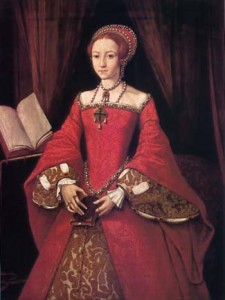On this day in 1533, Anne Boleyn gave birth to Princess Elizabeth at Greenwich.
Only two weeks earlier, on the 26th August 1533, after a relatively trouble-free pregnancy, Anne Boleyn took to her chambers at Greenwich to do what the royal physicians and astrologers had already predicted as certainty, give birth to a son and heir to the Tudor Throne.
In Elizabeth: The Struggle for the Throne, Starkey describes the chamber in great detail:
The walls and ceiling were close hung and tented with arras – that is, precious tapestry woven with gold or silver threads – and the floor thickly laid with rich carpets. The arras was left loose at a single window, so that the Queen could order a little light and air to be admitted, though this was generally felt inadvisable. Precautions were taken, too, about the design of the hangings. Figurative tapestry, with human or animal images, was ruled out. The fear was that it could trigger fantasies in the Queen’s mind which might lead to the child being deformed. Instead, simple, repetitive patterns were preferred. The Queen’s richly hung and canopied bed was to match or be en suite with the hangings, as was the pallet or day-bed which stood at its foot. And it was on the pallet, almost certainly, that the birth took place (Starkey, pg2).
42 years earlier, Elizabeth of York, had taken to her chambers at Greenwich, her favourite palace by the Thames, to give birth to her third child, Henry Tudor.
At 3 O’clock in the afternoon, on Sunday 7th September 1533, Anne Boleyn gave birth to a baby girl. The jousts that Henry VIII had planned to commemorate the birth of his son were cancelled as the birth of princesses did not warrant a large public celebration but ‘a herald immediately proclaimed this first of Henry’s legitimate children, while the choristers of the Chapel Royal sang the Te Deum’ (Ives, pg.184).
The circular letters prepared before the birth by the royal clerks, announcing the ‘deliverance and bringing forth of a Prince’ were amended to read ‘Princes’ (Starkey, pg. 507). One such letter survives today. It is written in the queens name and bears her signet:
Right trustie and welbiloved, we grete you well. And where as it hath pleased the goodnes of Almightie God, of his infynite marcie and grace, to sende unto us, at this tyme, good spede, in the delyveraunce and bringing furthe of a Princes,2 to the great joye, rejoyce, and inward comforte of my Lorde, us, and all his good and loving subjectes of this his realme; for the whiche his inestymable benevolence, soo shewed unto us, we have noo litle cause to give high thankes, laude, and praising unto oure said Maker, like as we doo mooste lowly, humbly, and with all the inwarde desire of our harte. And inasmuche as we undoubtidly truste, that this oure good spede is to your great pleasure, comforte, and consolation, We, therefore, by thies our letters, advertise you thereof, desiring and hartely praying you to give, with us, unto Almightie God, high thankes, glorie, laude, and praising; and to praye for the good helth, prosperitie, and contynuall preservation of the said Princes accordingly. Yeven under our Signet, at my Lordis Manour of Grenewiche, the 7 day of September, in the 25th yere of my said Lordis reigne.
To oure right trustie and welbiloved, the Lorde Cobham.
Elizabeth was not the male heir that Henry and Anne had hoped for, but the consolation was that she was healthy and had a full head of Tudor red hair. So the royal couple put on a brave face, as they had no reason to fear that sons would not follow. Weir relates how when Henry visited his wife after the birth and Anne expressed disappointment at the sex of their child Henry responded by saying that it was okay because they were both still young and ‘by God’s grace, boys will follow’ (Weir, pg. 258).
At her magnificent coronation, with her large belly embodying the hope of security, Anne must have felt untouchable. But now, with only a girl in the cradle, Anne’s position was weakened and only the birth of a son would bring her the stability she hoped for.
References
Ives, E. The Life and Death of Anne Boleyn, 2004.
Starkey, D. Elizabeth: The Struggle for the Throne, 2001.
Starkey, D. Six Wives, 2003.
Weir, A. The Six Wives of Henry VIII, 2007.
















It’s so sad to me that little Elizabeth came into the world a disappointment–and shemust have realized this early on….I wonder how much it impacted her character later.
I imagine that it would have had a huge impact on her character and the decisions she made in later life.
How do you different would Henry’s thoughts have been if he’d only known that between his prince and princess it was the girl that would rule the country and defeat the Spanish Armarda. How Prince Edward faded into history yet Elizabeth will live forever.